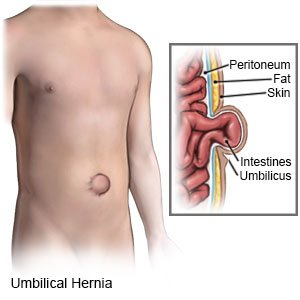Umbilical Hernia in Children
Medically reviewed by Drugs.com. Last updated on Aug 4, 2025.
AMBULATORY CARE:
An umbilical hernia
is a bulge through the abdominal wall near your child's umbilicus (belly button). The hernia may contain tissue from the abdomen, part of an organ (such as the intestine), or fluid.
 |
Common signs and symptoms:
Umbilical hernias usually do not cause pain. The hernia may disappear when your child relaxes or lies flat. Your child may have any of the following:
- A soft bulge or swelling near his or her belly button
- A bulge that gets bigger when he or she cries, coughs, strains to have a bowel movement, or sits up
- Vomiting or constipation
- Irritability or poor feeding
Seek care immediately if:
- Your child's hernia gets bigger, feels firm, or is blue or purple.
- Your child's abdomen seems larger, rounder, or more full than usual.
- Your child has severe abdominal pain with nausea or vomiting.
- Your child cannot have a bowel movement or pass gas.
- Your child has blood in his or her bowel movement.
- Your child cries more than usual or seems like he or she is in pain.
Call your child's doctor or gastroenterologist if:
- Your child has a fever.
- You have questions about your child's condition or care.
Treatment for your child's umbilical hernia
depends on how severe it is. The hernia may close on its own by age 4 to 5 years old and may not need treatment. Your child may need any of the following:
- Manual reduction of your child's hernia may be needed. Manual reduction means your child's healthcare provider will use hands to put firm, steady pressure on your child's hernia. Pressure is applied until the hernia disappears inside the abdominal wall.
- Surgery is done if your child's hernia does not go away on its own by age 4 to 5 years old or causes complications. Your child may need surgery right away if the hernia stops blood flow to any of his or her organs. Your child may also need surgery right away if a hole forms in the intestines or they get trapped inside the hernia.
Care for your child:
- Give your child liquids as directed. Liquids may prevent constipation and straining during a bowel movement. Ask how much liquid to give your child each day and which liquids are best for him or her.
- Give your child foods high in fiber. Fiber may prevent constipation and straining during a bowel movement. Foods that contain fiber include fruits, vegetables, legumes, and whole grains.

- Do not put pressure on your child's hernia. Do not push on the hernia or place tape or a coin over it.
Follow up with your child's doctor or gastroenterologist as directed:
Write down your questions so you remember to ask them during your visits.
© Copyright Merative 2025 Information is for End User's use only and may not be sold, redistributed or otherwise used for commercial purposes.
The above information is an educational aid only. It is not intended as medical advice for individual conditions or treatments. Talk to your doctor, nurse or pharmacist before following any medical regimen to see if it is safe and effective for you.
Learn more about Umbilical Hernia
Treatment options
Care guides
Symptoms and treatments
Further information
Always consult your healthcare provider to ensure the information displayed on this page applies to your personal circumstances.
